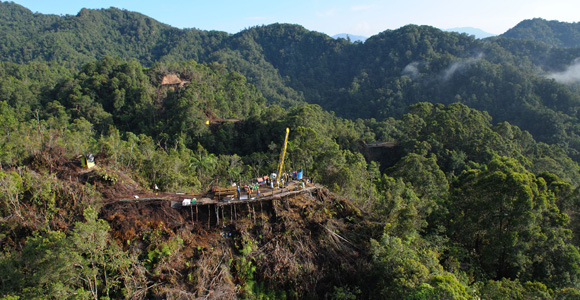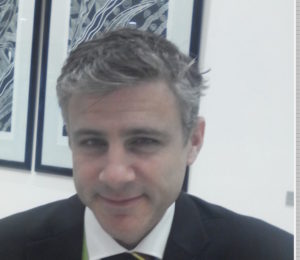PanAust has released its feasibility study into the Frieda River mine in Sandaun Province, claiming it is ‘one of the largest undeveloped copper-gold deposits in the world’, with an initial 17-year mine life. The company’s intention is to take a staged approach to development.

The Frieda River project in Sandaun Province. Credit: Xstrata Copper
The feasibility study found that there are over 2.7 billion tonnes of mineralisation at an average grade of 0.42 per cent of copper and 0.23 grams per tonne of gold. The study is projecting average annual production of 175,000 tonnes of copper concentrate and 250,000 ounces of gold.
‘We recognize that a large part of this project is all about waste and water management.’
The direct cash cost of copper production, including transportation and freight, treatment and refining charges and marketing costs, is projected to be US$0.69 per pound. Copper is currently trading at US$2.10 per pound.
US$3.6 billion investment
According to PanAust, it will place the mine ‘within the first quartile of the global copper cost curve once hydroelectric power is introduced.’
The feasibility study estimates the cost of the development of the project to be US$3.6 billion. The payback period for that investment is estimated to be six years from the start of production. A further US$2.3 billion is to be invested over the life of the mine.
PanAust expects to submit an application for a Special Mining Lease covering the project by June 30. PanAust owns an 80% interest in the project, with the remaining 20% held by Highlands Pacific.
Challenges

PanAust’s Glen Connell Source: Business Advantage International
Glen Connell, General Manager, Government and Community, for PanAust told the Australia Papua New Guinea Business Forum in Cairns earlier this week, that there are significant environmental and logistical challenges.
‘We recognise that a large part of this project is all about waste and water management,’ he said.
‘The integrated storage facility solution that we are investigating, and will compose, will house waste rock and tailings. And then, after year five of production, it will produce hydro-electricity—probably about 60 per cent of the project’s needs after that time.
‘That integrated storage facility sits at the end of the valley in which we are operating, so sediment waste water run off will all go into that facility. It really is the centre piece of our environmental management strategy.
‘It is a very big deposit with many years of production. But in order to get to that point you need to start small.’
‘A new airport will be developed and we are hoping there might be some commercial application for that, which will help the local communities and the economy of the region.’
Sepik River
Once the mine is operating, Connell said, 4,000 tonne barges will travel up the Sepik River ‘probably one every two days or one every one-and-a-half days.’ He claimed it will be the mine’s main impact on the river, because its integrated storage facility will hold all the sediment.
‘The basic philosophy we have taken to this is to think big. It is a very big deposit with many years of production. But in order to get to that point you need to start small.’
Connell said the project is as much a logistics project as a mining project, pointing out that it is not near a port, the coast or a power source.
‘There is mining, processing, power supply, power generation and transmission and non-processing infrastructure.’
It is also exposed to commodity price fluctuations. Connell noted that the copper price had fallen by 35 per cent since the company acquired its interest from Glencore Xstrata in August 2014.
‘We are talking decades here, so we are taking a very long-term view,’ said Connell, adding that the mine ‘could go for 30-plus years.’
Several projects
Because of the scale of the operation, the challenge is multifaceted, said Connell. ‘There is mining, processing, power supply, power generation and transmission and non-processing infrastructure. And there is a quite complex logistics chain.
‘It will very much be several projects being managed, only two of which relate to the actual mining and processing of the mineral resource.’
‘This is one of the biggest undeveloped copper projects in the world’
Connell said the mine could be a ‘game changer in terms of the socio-economic development’ of the provinces of Sandaun and East Sepik. ‘It has the potential to open up the region to new economic opportunities,’ he said.
The development of the mine will have to be undertaken without significant road infrastructure, although Frank Kramer, Chairman of Kumul Petroleum, told the Forum that developing a connecting highway for the Frieda River project should be a ‘national development project.’
Caution
Connell said the company has already made a significant commitment of resources. ‘At last count we were approaching 240,000 man hours and in excess of $60 million invested in further work.’
With construction set to take around six years, he was cautious about time lines, however:
‘When will we put the first shovel in the ground? The answer is: “I don’t know.”’
The project’s joint venture partner, Highlands Pacific, has welcomed the release of the study.
‘This is one of the biggest undeveloped copper projects in the world, and this study represents an important step in the process towards developing the project profitably and in the interests of all stakeholders,’ said Highlands Pacific’s Managing Director John Gooding in a statement.








Speak Your Mind